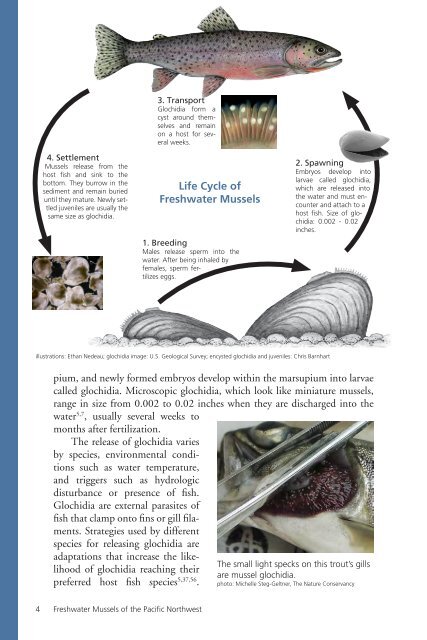Freshwater Mussels Pacific Northwest - The Xerces Society
Freshwater Mussels Pacific Northwest - The Xerces Society
Freshwater Mussels Pacific Northwest - The Xerces Society
You also want an ePaper? Increase the reach of your titles
YUMPU automatically turns print PDFs into web optimized ePapers that Google loves.
4. Settlement<br />
<strong>Mussels</strong> release from the<br />
host fish and sink to the<br />
bottom. <strong>The</strong>y burrow in the<br />
sediment and remain buried<br />
until they mature. Newly settled<br />
juveniles are usually the<br />
same size as glochidia.<br />
1. Breeding<br />
Males release sperm into the<br />
water. After being inhaled by<br />
females, sperm fertilizes<br />
eggs.<br />
pium, and newly formed embryos develop within the marsupium into larvae<br />
called glochidia. Microscopic glochidia, which look like miniature mussels,<br />
range in size from 0.002 to 0.02 inches when they are discharged into the<br />
water 5,7 , usually several weeks to<br />
months after fertilization.<br />
<strong>The</strong> release of glochidia varies<br />
by species, environmental conditions<br />
such as water temperature,<br />
and triggers such as hydrologic<br />
disturbance or presence of fish.<br />
Glochidia are external parasites of<br />
fish that clamp onto fins or gill filaments.<br />
Strategies used by different<br />
species for releasing glochidia are<br />
adaptations that increase the likelihood<br />
of glochidia reaching their<br />
preferred host fish species 5,37,56 .<br />
Life Cycle of<br />
<strong>Freshwater</strong> <strong>Mussels</strong><br />
illustrations: Ethan Nedeau; glochidia image: U.S. Geological Survey; encysted glochidia and juveniles: Chris Barnhart<br />
4<br />
3. Transport<br />
Glochidia form a<br />
cyst around themselves<br />
and remain<br />
on a host for several<br />
weeks.<br />
<strong>Freshwater</strong> <strong>Mussels</strong> of the <strong>Pacific</strong> <strong>Northwest</strong><br />
2. Spawning<br />
Embryos develop into<br />
larvae called glochidia,<br />
which are released into<br />
the water and must encounter<br />
and attach to a<br />
host fish. Size of glochidia:<br />
0.002 0.02<br />
inches.<br />
<strong>The</strong> small light specks on this trout’s gills<br />
are mussel glochidia.<br />
photo: Michelle Steg-Geltner, <strong>The</strong> Nature Conservancy

















